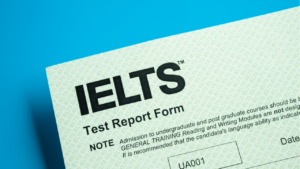Did you know? International English Language Testing System, or IELTS, is the most popular English proficiency test used worldwide. Let’s uncover what makes it so popular!
IELTS tests your skills in four sections:
Each segment of the IELTS exam will be scored between 0 and 9. Out of all the sections of the IELTS exam, the IELTS Listening test is the one that requires more attention.
You will have 40 questions based on 4 recordings under 4 sections in the IELTS listening section. These recordings feature various speakers’:
- Daily conversations
- Academic lectures
- Group conversations
- Monologues
This section assesses your ability to understand spoken English and analyses how well you process facts and information. These factors play a crucial role in university-level education.
Crack IELTS Exam in first attempt
Attend Leap’s free masterclass to get tips, tricks and advance strategies to crack IELTS exam in first attempt

In this blog, you will find a detailed overview of the Listening section along with the samples.
Also read: IELTS Listening 2023: Video Library Application Form Answers & Expert Tips
IELTS Listening Format
Crack IELTS Exam in first attempt

Attend Leap’s free masterclass to get tips, tricks and advance strategies to crack IELTS exam in first attempt
The IELTS listening test section is allotted 30 minutes for completion. As per the new update, students will begin with the test after hearing the instructions.
The four parts are conversations between English speakers. Each section will have about 10 questions.
The overview of the IELTS listening parts is shown below.
| Parts | Number of Speakers | Description |
|---|---|---|
| Part 1 | 2 | A casual conversation in a social setting. |
| Part 2 | 1 | A monologue in an everyday social background. For instance, a speech about local amenities in the area. |
| Part 3 | 4 | A discussion set in an educational context. |
| Part 4 | 1 | An academic lecture |
Also read: IELTS Listening 2023: Youth Council Listening Answers With Expert Guidance
IELTS Listening: Types of Questions
1. Multiple Choice: For every MCQ, you will be presented with three possibilities. These could be in question-and-answer format, or they could be in complete-the-sentence form.
You can select only one option among A, B, and C. Sometimes, you will be specified to choose more than one answer from a longer list of possibilities. We strongly advise taking some time to read the questions.
How to answer:
- Read the questions carefully and identify the keywords.
- Make notes of crucial information while listening to the audio.
- Use the process of elimination to finalise your answer.
| Example: What is the main reason the speaker gives for choosing a vegetarian diet? a) Health benefits b) Environmental concerns c) Cultural preferences |
2. Matching: You must match the correct items from a list of possibilities to the IELTS listening test audio played. These questions assess your ability to recognise facts and comprehend how well you can follow exchanges between two or more people.
How to answer:
- Read the questions carefully and spot keywords.
- Think of synonyms and other ways in which keywords can be expressed.
- Try to map down these words with the audio in the form of a chart or table so it’s easier to match.
| Example: Match the names of the employees with their respective departments. Departments: a. Marketing b. Finance c. Human Resources Employees: I. Maria ______ II. John ______ III. Robert ______ |
3. Plan, map, and diagram labelling: For such questions, you must label a map, plan and diagram. These are designed to test how well you can visually interpret your understanding.
Though these questions might appear anywhere, they typically occur in part 2.
How to answer:
- Read thoroughly and recognise the keywords.
- Draw your compass and pay attention to directions. You don’t always get straightforward tips, so make sure you are familiar with phrases used in these types. Example: On the top of generally means to the north of something.
| Example: Label the map with the correct names of the city landmarks. (You’ll get a map with numbered locations) |
4. Sentence completion: As the name implies, you must choose one of the three provided answers to finish the sentence.
The sentence might not be the same sentence you hear in the recording, but it will convey the same meaning.
How to answer:
- Read the sentences thoroughly before the audio is played.
- Mentally note the important keywords or underline them in the sentence. Be attentive to these keywords when you hear the recording.
- Make notes you can look back on.
- You will have a word count of 2 or 3. Make sure your answer is accurate.
| Example: Complete the sentence with the missing information. The speaker recommends students to start preparing for the exam at least ________ months in advance. |
5. Short-answer questions: This is a typical question-answer type. You will read the question and write a short answer to it.
These questions also have a strict word count. Sometimes, you might have to answer in 2-3 points.
How to answer:
- Be attentive to the questions and note the keywords.
- Pay attention to words and question words. Example: If you are asked “why”, you will have to reason with your answer rather than stating your opinion.
- Abide by the word count. Anything more than the word limit will cost you points. Hyphenated words will count as single words.
| Example: Provide a brief answer to the question. What is the primary theme of the lecture on climate change? |
6. Form, note, table, flowchart, summary completion: These types of questions prompt you to complete the outline. Each type is explained below.
Form: After listening to a conversation, you must fill in details, such as contact number, name, and address.
Note: You must summarise the information according to the layout and show different items that relate to one another.
Table: You must fill out category information, such as place, cost, or arrival. Flow chart: You must complete the process as displayed by arrows.
| Example: Complete the table with the missing information. (Table with headings like Date, Event, Location) | Date | Event | Location | | _____ | International Day | _____ | |
Remember, these examples are illustrative, and the actual content and complexity may vary in the IELTS listening test.
Also read: Holiday Rentals IELTS Listening Answers 2023: Best Sample Questions For Your Practice
IELTS Listening Practice Test: Sample
Instructions:
- Listen to the audio recordings carefully.
- Answer the questions based on what you hear.
- You will have time to read the questions before each recording.
Recording 1: Conversation
Questions 1-5
You will hear a conversation between two friends discussing travel plans. Listen and answer the following questions.
| Transcript: Woman: Hey, have you thought about our upcoming trip? Man: Yeah, I’m excited. Where should we go? Woman: I was thinking of Paris. What do you think? Man: Paris sounds great! When should we leave? Woman: How about next month? And how should we travel – by train, plane, or car? Man: I prefer flying. It’s faster. What do you think? Woman: I agree. Let’s book our flights. We can pack our bags later. |
Questions:
- Where are the friends planning to go?
- A) Paris
- B) New York
- C) Tokyo
2. When do they plan to leave for their trip?
- A) Next week
- B) Next month
- C) Next year
3. What mode of transportation do they consider for their journey?
- A) Train
- B) Plane
- C) Car
4. Why does the woman prefer a certain option?
- A) Faster travel time
- B) More scenic route
- C) Cheaper fare
5. What does the man suggest they do first?
- A) Book accommodation
- B) Plan sightseeing
- C) Pack their bags
| Answers: 1. A) Paris 2. B) Next month 3. B) Plane 4. A) Faster travel time 5. C) Pack their bags |
Recording 2: Monologue (Social Situation)
| Transcript: Speaker: Good evening, everyone! I’m thrilled to announce our upcoming social event. It’s a birthday party at the Riverside Restaurant. The party starts at 8:30 PM. Please RSVP by sending an email to events@riversiderestaurant.com. The dress code is business casual. We look forward to celebrating together! |
Questions:
6. What type of event is the speaker describing?
- A) Wedding
- B) Birthday party
- C) Business conference
7. Where is the event taking place?
- A) Hotel
- B) Restaurant
- C) Conference centre
8. What time does the event start?
- A) 7:00 PM
- B) 8:30 PM
- C) 6:00 PM
9. How should attendees RSVP for the event?
- A) Email
- B) Phone call
- C) Online form
10. What is the dress code for the event?
- A) Casual
- B) Formal
- C) Business casual
| Answers: 6. B) Birthday party 7. B) Restaurant 8. B) 8:30 PM 9. A) Email 10. C) Business casual |
Recording 3: Conversation (Group)
| Transcript: Friend 1: Let’s plan a weekend getaway! Friend 2: How about the mountains? We can go hiking and camping. Friend 3: Sounds fun! How should we get there? Friend 1: Let’s carpool. What’s our budget? Friend 2: I suggest $200 per person. Friend 3: Great! When should we leave? Friend 1: Friday evening works for me. |
Questions:
11. Where are the friends planning to go for the weekend?
- A) Beach
- B) Mountains
- C) City
12. What activities do they consider doing during the weekend?
- A) Hiking and camping
- B) Sunbathing and swimming
- C) Sightseeing and shopping
13. How do they plan to travel to their destination?
- A) Carpool
- B) Bus
- C) Train
14. What is the budget for the weekend trip?
- A) $200 per person
- B) $500 per person
- C) $100 per person
15. When do they decide to leave for the trip?
- A) Friday evening
- B) Saturday morning
- C) Sunday afternoon
| Answers: 11. B) Mountains 12. A) Hiking and camping 13. A) Carpool 14. A) $200 per person 15. A) Friday evening |
Recording 4: Monologue (Academic Context)
| Transcript: Lecturer: Today, we’ll discuss the impact of modern technology on literature. The rapid changes pose challenges, such as insufficient research. Take the example of the e-book – a revolutionary development. To address these challenges, increased collaboration among researchers is crucial. This will ensure the continued growth of literature in our tech-driven era. |
Questions:
16. What is the lecture primarily about?
- A) History of literature
- B) Modern technology
- C) Environmental issues
17. According to the speaker, what is the main challenge in the discussed field?
- A) Lack of funding
- B) Rapid changes
- C) Insufficient research
18. What example does the speaker give to illustrate a point?
- A) A famous author
- B) A scientific experiment
- C) A historical event
19. What does the speaker suggest as a possible solution to the challenge?
- A) Increased collaboration
- B) Advanced technology
- C) Strict regulations
20. What is the speaker’s overall tone throughout the lecture?
- A) Optimistic
- B) Critical
- C) Neutral
| Answers: 16. B) Modern technology 17. B) Rapid changes 18. B) A scientific experiment 19. A) Increased collaboration 20. A) Optimistic |
Please note: The above sample test is just a practice test, the actual IELTS Listening test will have total 40 questions. Each section will have 10 questions.
The questions are taken from the Cambridge book for IELTS preparation.
Calculate IELTS Listening Test Scores
Both the IELTS Academic and General modules for IELTS Listening test are marked on a 9-band scale.
The IELTS Listening test comprises questions based on four audio recordings, each depicting different scenarios. These recordings contain: various situations encountered in daily life, including:
In total, there are 40 questions in the Listening test, with one mark awarded for each correct answer. The total number of correct answers determines your final Listening band score.
For example, a raw score of 35 out of 40 corresponds to a band score of 8 on the Listening test. This score is then factored into calculating your overall IELTS band score.
Please note:
If the average is close to .25, it rounds to the nearest half-band. If it’s closer to .75 or higher, it rounds to the nearest whole band.
But if it’s less than .25 or .75, it rounds down to the nearest lower whole or half-band score.
| Correct Answers | Band Scores |
|---|---|
| 39-40 | 9 |
| 37-38 | 8.5 |
| 35-36 | 8 |
| 32-34 | 7.5 |
| 30-31 | 7 |
| 26-29 | 6.5 |
| 23-25 | 6 |
| 18-22 | 5.5 |
| 16-17 | 5 |
| 13-15 | 4.5 |
| 11-12 | 4 |
Tips for IELTS Listening Practice Test
If you aspire to achieve a good score, you must follow these essential tips.
- Know the Test Style: Understand how the Listening test is set up and practice with similar questions so you’re familiar with what to expect.
- Listen to English Regularly: Make a habit of listening to English audio like podcasts, news, or lectures to improve your overall listening skills.
- Listen to Different Sources: Listen to various accents, speeds, and situations to prepare for the different scenarios in the actual test.
- Use Real IELTS Material: Practice with real IELTS listening practice tests, like official practice tests, to get a feel for the real thing.
- Take Good Notes: Learn to take effective notes by focusing on keywords and important information while listening.
- Manage Your Time: Practice managing your time during each section so you don’t run out of time during the actual test.
- Create Test Conditions: Practice in a quiet space without distractions, and use headphones to mimic the test environment.
- Learn from Mistakes: Understand any mistakes you make during practice and focus on those areas to improve.
- Build Your Vocabulary: Work on your vocabulary, especially words related to common IELTS topics.
- Predict Information: Practice predicting information based on what you hear, which can help in certain question types.
- Pay Attention to Signposts: Notice transitional phrases in the audio that indicate changes in topic or new information.
- Check Your Spelling: Be careful with your spelling, especially in tasks where it matters.
- Stay Calm: Keep calm during the test. If you miss an answer, move on to the next one without panicking.
- Use Breaks Wisely: Use breaks between sections to review notes and quickly prepare for the next part.
- Get Feedback: Have someone review your practice tests to give you feedback on what you’re doing well and where you can improve.
Also read: Top 9 IELTS Listening Tips & Strategies To Improve Your IELTS Score – Leap Scholar
Final Thoughts
The IELTS Listening test is straightforward, although it does necessitate some practice and preparation. The trick is to carefully listen to the instructions and extract the keywords before attempting any questions.
To avoid getting caught off guard, practise answering all types of questions. To ensure the best chance of scoring in IELTS, enrol in our free IELTS masterclass today!
Get access to IELTS resources, IELTS Listening practice tests, and video lessons from our experts.
Book a free call today!
Frequently Asked Questions
-
Q: What does the listening test consist of?
A: The IELTS listening test comprises four distinct sections, each featuring different audio recordings. These sections are time-bound, and you must manage your time effectively to respond to questions accurately. Following the 30-minute listening period, you are granted an extra 10 minutes to transfer your answers from the question booklet to the official answer sheet.
-
Q: How can I practice the IELTS listening test?
A: IELTS listening practice can be accomplished by actively listening to previous audio recordings, such as podcasts, lectures, or news clips, and by working through sample IELTS listening test papers. Regular practice is crucial for developing effective listening skills and knowing the test format.
-
Q: How can I get 8.5 in listening?
A: Attaining a band score of 8.5 in the listening section of the IELTS test requires candidates to answer 36 out of 40 questions accurately. Consistent and focused practice, along with a good understanding of the question types, is essential to reach this level.
-
Q: How many times can I hear the recording in the IELTS listening test?
A: In the IELTS listening test, candidates have only one opportunity to listen to each recording. Therefore, paying close attention and focusing during the initial playback is crucial for comprehending the information presented.
-
Q: Does spelling matter in IELTS listening?
A: Correct spelling is crucial in the IELTS listening test, as it is in all other sections of the exam. Accurate spelling contributes to demonstrating your overall English language proficiency and is a factor considered in scoring.
-
Q: What does the IELTS Listening Practice Test for 2024 entail?
A: The IELTS Listening Practice Test for 2024 is a comprehensive resource designed to mirror the structure and content of the actual IELTS listening test. It includes a set of audio recordings accompanied by questions, offering a simulated test environment for effective practice.
-
Q: Where can I find the audio for the practice test?
A: You won’t need to search for external audio sources. The IELTS Listening practice test package comes complete with the necessary audio files, making it convenient for you to access and engage with the IELTS Listening practice test materials as part of your preparation.
-
Q: Are the answers included in the practice test materials?
A: Absolutely, the IELTS Listening practice test materials include comprehensive answer keys. This allows you to cross-reference your responses with the correct answers, providing valuable feedback on your performance.
-
Q: How can I use the IELTS Listening Practice Test effectively?
A: To make the most of your practice, treat IELTS Listening practice test as if you were taking the real test. Practice in a quiet environment, use headphones if possible, and strictly adhere to the time limits for each section. After completion, carefully review both the questions and answers to gain insights into your performance and areas that need refinement.
-
Q: Can I take the IELTS Listening Practice Test multiple times?
A: Certainly, you are encouraged to take the practice test multiple times. By taking the IELTS Listening Practice Test multiple times, you reinforce your understanding of the test format, enhance your ability to manage time efficiently, and gradually build confidence in tackling a variety of listening scenarios.
-
Q: Is the IELTS Listening Practice Test for 2024 suitable for all skill levels?
A: Yes, the IELTS Listening practice test is thoughtfully designed to cater to various skill levels. Whether you are a beginner or aiming for a higher band score, the flexible nature of the practice test allows you to tailor your preparation to meet your specific needs and progressively advance your listening proficiency.
-
Q: Can I use the IELTS Listening Practice Test on different devices?
A: The IELTS Listening practice test is user-friendly and adaptable, allowing you to practice on your chosen device. Whether you prefer using a computer, tablet, or smartphone, the materials are optimised for different screen sizes, enabling you to engage in effective IELTS listening practice anytime, anywhere.






